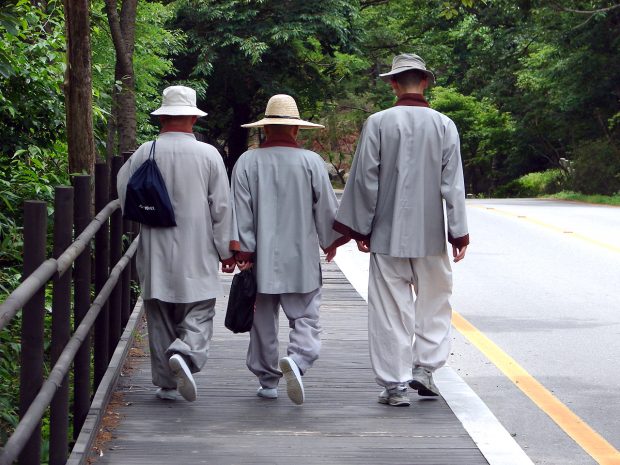Prostrating monks call for truth in Myanmar worker’s death
Several Korean monks displayed a rare religious practice on Monday to demand the government investigate the death of a Myanmar migrant worker two months ago. The pro-immigration activists performed the three-steps-and-one-prostration-bow practice, starting from Jogyesa in Jongno-gu, Seoul ― the headquarters of the Jogye Order of Korean Buddhism. Each monk repeated a cycle of taking three steps followed by prostrating on the road. The seemingly excruciating practice continued to the presidential residence Cheong Wa Dae some 1.6 kilometers away.
A monk held a black and white photo of Than Zaw Htay, who fell eight meters at a construction site in Gimpo while trying to escape an Incheon immigration office raid targeting illegal aliens on Aug. 22. The man, 25, was taken to hospital but died 13 days later. The Jogye Order of Korean Buddhism’s social and labor committee organized Monday’s protest, demanding Gimpo Police Station, which investigated the incident and initially thought the worker killed himself, and the Ministry of Justice re-open the case. Gimpo police now believe the worker fell accidentally. Some 30 joined the protest, calling the Incheon immigration inspectors’ handling of the incident a “murderous raid.” Witnesses said the inspectors grabbed the worker’s legs as he was escaping through a window, causing him to lose footing and fall.
Committee president Ven. Haechan claimed a hospital record wrongfully indicated the worker accidentally fell and Gimpo police cited this in not bringing charges against the Incheon immigration authority. He said the committee had demanded from police and the ministry the raid’s original video recording, the pre-raid documented plan and post-raid report. But they said the police and ministry had repeatedly responded that they could only release some of the material. Ven. Haechan called Monday’s religious practice “our physical proclamation carrying our desperate request for the truth and intent for those responsible to be punished. The monk also called the protest “our bodily gesture to demand a stop to this murderous raid in a ‘rabbit-herding’ style that has already killed 10 migrant workers, including the Myanmarese, in the past 10 years.”
By Ko Dong-hwan
(Korea Times)

























































